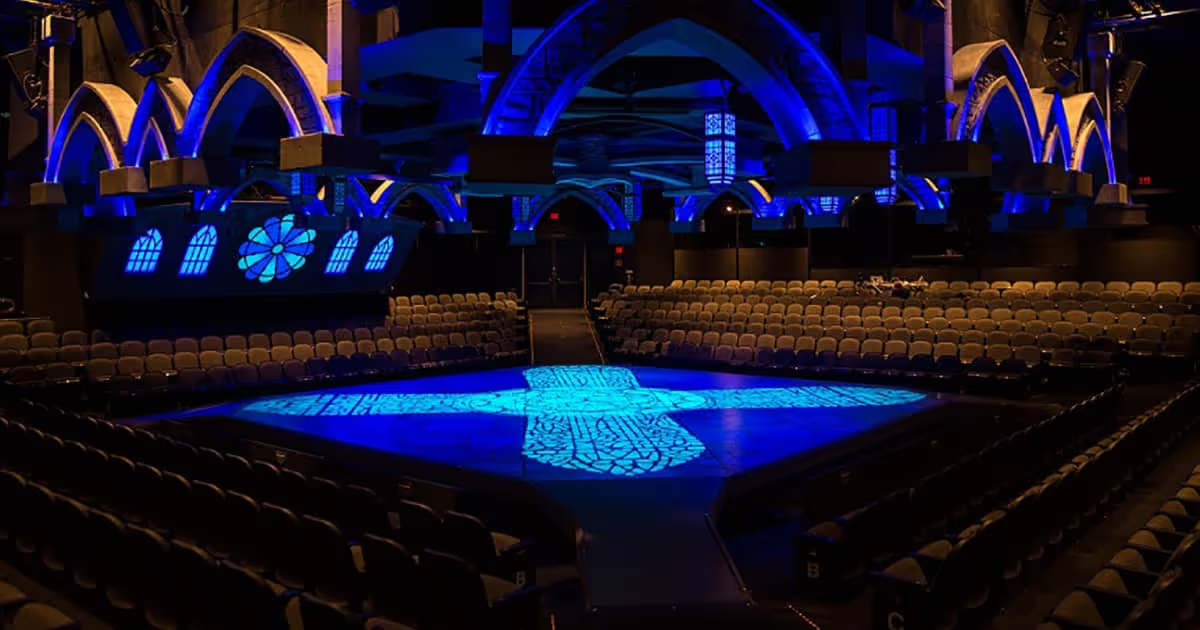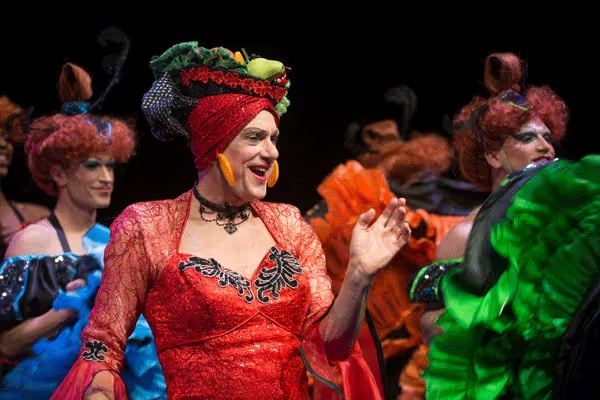La Cage aux Folles
In 1983, “La Cage aux Folles” opened on Broadway as perhaps the first musical to deal openly with homosexuality. The show became a major hit without generating much controversy for its then unconventional theme. Audiences flocked to see “La Cage” because it was a delightful musical in the Broadway tradition of easy to take comedy, elaborate production numbers, and an ingratiating love story.
The revival at the Marriott Theatre presents “La Cage aux Folles” as a fun show, which it is. The gay theme is treated with much humor and some charm. This isn’t “The Boys in the Band” or “The Normal Heart.” It is Broadway at its most accessible and least threatening, with a melodic and bouncy score by Jerry Herman and plenty of rousing song and dance numbers staged with sizzle and wit by director Joe Leonardo and choreographer Melissa Zaremba, gaudily costumed by the always inventive Nancy Missimi.
The departure from the norm of Broadway musicals was the love story, not the traditional boy-girl romance but an affecting relationship between two middle-aged men who had been together for more than 20 years. The men are Georges and Albin, who run a drag nightclub named “La Cage aux Folles” at some unspecified time on the French Riviera. Georges is the club’s master of ceremonies and Albin is Zaza, the drag star of the evening. Albin/Zaza performs in front of a chorus of eight men dressed in glorious and convincing as sexy young women.
The club’s floorshow musical numbers provide the show’s major pleasures, but there is a storyline. It seems that 20 years previously, Georges had a one night stand with a promiscuous actress that resulted in an offspring named Jean-Michel. Georges and Albin raised the child as mother and father like a typical nuclear family. Now Jean-Michel wants to marry, and the hook is that his fiancée’s father is a bigoted politician running on a puritanical morals platform. Jean-Michel wants to bring his young lady and her parents to meet his “mother and father,” but Albin is an embarrassment whose homosexuality would scuttle the lad’s marriage plans. So Albin has to go back into the closet, at least during the brief stay of his fiancée and her folks. Albin naturally is outraged and offended at his dismissal, venting his outrage with the show’s major emotional moment, Albin’s defiant rendition of “I Am What I Am,” which could serve as a national anthem for the gay community.
The Marriott staging goes all out for the broad comic opportunities built into a musical about transvestites and drag performers. The show cheerfully thumbs its nose at political correctness about gay matters. In one scene, Georges and Albin agree to soothe Albin’s injured feelings by agreeing to pass him off as the boy’s Uncle Albert when the fiancée’s parents arrive. But Albin exudes a full range of a caricature gay man’s physical and vocal mannerisms. Georges and Jean-Michel try to instruct him to “man up” by shedding his swishy walk and way of speaking. The scene wallows in gay stereotypes but audiences of all sexual persuasions should join in laughing at what actually is a classic case of gender profiling.
Throughout the show, the gay/straight dichotomy comes in for a stream of low comedy wisecracks that neither the ultra homophobic nor the extreme liberal spectator should take amiss. At the end of the show Jean-Michel and his bride to be are saved by an astoundingly improbable bit of chicanery that properly humiliates the bigoted politician.
“I Am What I Am “ is the showcase song in the show, but there is a charming number called “Song on the Sand” and a poignant tune called “Look Over There,” both illuminating the Georges/Albin relationship for what it is, warm and loving and enduring, whatever their small barbed conflicts in their daily lives. My favorite song is the cheerful “The Best of Times,” sung at a restaurant by all the major characters for no narrative reason other than it’s a very listenable song.
The cast is headed by David Hess as Georges and Gene Weygandt as Albin. Hess has a strong voice and a solid, straightforward manner that plays nicely off Weygandt’s mincing Albin. Weygandt is most effective on the nightclub stage as Zaza, bantering archly with the spectators and wearing a vast wardrobe of gowns and wigs with style and ease.
The supporting performers are led by the eight young men in the nightclub chorus, all singing and dancing well and generally convincingly feminine. Joseph Anthony Byrd is properly over the top as Albin’s flaming queen maid/butler Jacob, a character the audience eats up. Brian Bohr is a very credible Jean-Michel, a lad who loves his parents but is inwardly ashamed of their lifestyle and the miseries he has endured from tormenting young people as he grew up. But Jean-Michel wises up by the end of the evening and recognizes that he’s really been a lucky boy.
I commend Fred Zimmerman for taking the realistic road in his portrayal of the Edouard Dindon, the narrow-minded politician. Zimmerman’s restrained performance as the self-righteous Dindon offers a brief reminder that such men exist in our midst where they are not dealt with so easily as Dindon is in “La Cage.” Elizabeth Telford is bright and sunny as Anne, the fiancée and Anne Gunn is fine as Dindon’s intimidated wife. Susan Moniz does an excellent cameo as the proprietor of the restaurant who improvises the plan to put the politician in his place.
Nancy Missimi’s costumes have to carry the visual splash of the show, the theater’s in-the-round stage precluding the use of much scenery. Still, Thomas M. Ryan does what he can with the limited opportunities for spectacle. Jesse Klug designed the lighting and Robert E. Gilmartin the sound, with Sally Weiss in charge of the properties that make up most of the set. Ryan T. Nelson directs the excellent off stage Marriott orchestra.
In sexual matters, “La Cage aux Folles” probably isn’t much more relevant today that it was more than 30 years ago. The story exists in a fantasyland that deals in outlandish characters and the broadest of sentiments and comedy rather than explorations of a serious cultural situation. So, nobody likely will be stimulated but nobody should be offended either. But much joy remains in the show’s 2½ hours because Joe Leonardo and Melissa Zaremba have created a production that entertains from first moment to last.











